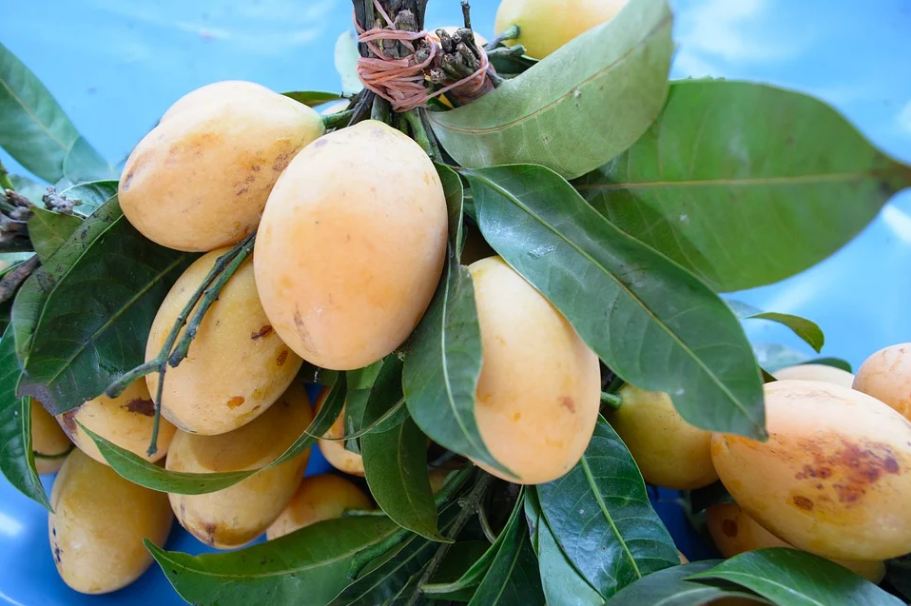Mango is an ancient tree! It is believed to have existed about 4000 years back. As old as 300 years old, mango trees can still bear fruits, and it is proven by the oldest mango tree found in East Khandesh that still produces viable fruits.
Mango boasts as being one of the most eaten fruits in the world because of its delicious taste, sweet aroma, and is jam-packed with vitamins. So, who can ever resist? Unless someone has allergies to it. Mango is a national fruit of countries like the Philippines, India, and Pakistan.
The vitamin content of mango varies on the fruit’s variety and maturity. Green mangoes have significantly higher vitamin C content, but as the fruit ripens and matures, the amount of vitamin A it contains increases.
There are hundreds of mango varieties worldwide, yet only six are readily available in the United States, namely; Ataulfo, Haden, Francis, Tommy Atkins, Kent, and Keitt.
Texas’ Keitt mangoes are mangoes grown in the United States. It has green outer skin but bright-orange and sweet inside. While in Houston, the Tommy Atkins mangoes are grown. They have a sweet and mild flavor. Kent is another mango variety grown in the United States. It tastes like a cross between a peach, pineapple, and mandarin orange.
How to Grow a Mango Plant
Consider the mango tree as your friend. It needs basic things to survive, grow healthy, and produce many fruits. Your mango tree will be happy when it is under plenty of light and warmth. And it doesn’t like temperatures below 40 degrees Fahrenheit. It might cause its fruits to drop if they get too cold.
Soil
Soil is always a crucial component in growing plants. It is ideal for your mango trees to have a rich, peat-based potting soil with excellent drainage. When you plant them in the garden, make sure they are on the soil that can dry out slightly between watering.
Mango trees can thrive in various types of soil. Its tree develops a strong taproot shortly after planting. It continues to grow until it reaches the soil water-table, and under favorable conditions, it can penetrate the soil to a depth of 6 m.
Water
Throughout the first two years, mango trees should be regularly watered to supplement rainfall and encourage growth. Every week, water each tree with about 26 gallons of water. You only stop watering one the tree is in the flowering and fruiting periods, usually July through November. This is to increase the number of flowers and keep the formed ones from dropping. Thus, controlling maximizing fruit yields.
Temperature and Humidity
The best humidity for mango plants is above 50 percent. Therefore, you may need to mist your mango plants daily. As much as possible, keep your tree at above 50 degrees Fahrenheit. Take note that mango plants cannot tolerate freezing, and even at 40 degrees, because their flowers or young fruits will drop.
Growing mango trees outdoors needs a warm climate with an average temperature of 80 to 100 degrees Fahrenheit. If you have planted your mangoes in the containers, you can put them outside to enjoy the sun during warm summers.
Temperatures between 27 and 36 °C provides optimum growth and production of the mangoes.
Wind
The windy area is not safe for mangoes, especially when they start to bloom flowers. Even moderate winds may scratch marks on fruits where fungi or bacteria can have passage to damage the fruit. Scratched fruits don’t pass the quality for marketing.
What is even worse is the stronger winds that will cause many fruit losses, resulting in lower yields. Zill, Haden, and Kent varieties are prone to a greater extent to fruit loss under windy conditions than others.
Damage to mango trees caused wind can be minimized through:
- Avoiding very windy areas.
- Putting up windbreaks such as artificial structures or fast-growing trees on the upwind side of prevailing winds. Mango orchards are best arranged so that the rows run diagonally to the prevailing wind direction to avoid creating a funnel effect.
- Pruning the non-bearing flower panicles when it’s evident that they will not bear any fruit, as they will become dry and hard and cause scratch marks on the fruit.
Fertilizers
It is recommended by the University of Hawaii horticulturalists to have 1 pound of complete, slow-release fertilizer each year for each inch of trunk diameter 4 to 5 feet above the ground.
Apply one half of this fertilizer during mango’s flowering, and the rest after the mangoes are harvested.
Satisfactory mango tree fertilizer mixes readily available include 6-6-6 and 8-3-9-2, the 2 indicating magnesium.
To boost flowering and mango produce, apply additional rapid-release fertilizers containing nitrogen just before mango trees flower.
Fertilizers for bearing trees should generally contain 9 to 15 percent potassium, and phosphorus should be reduced to 2 to 4 percent.


